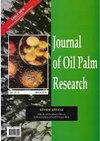用作覆盖材料的油棕空果梗的热物理特性
IF 1.3
4区 农林科学
Q2 Agricultural and Biological Sciences
引用次数: 0
摘要
选择覆盖或表层土覆盖材料来减缓蒸发造成的土壤水分损失,需要对材料的热特性有很好的了解。油棕榈空果串的果穗是从乌约当地的一些油棕榈加工单位获得的,在成型前用水浸泡并完全风干,并对样品进行各种实验室测试。样品的体积密度、吸水率、热导率、比热容、体积热容、热扩散率、热渗出率和太阳辐射吸收率分别为(332.59±0.65)kg m–3、(269.54±1.28)%、(0.078±0.001)W m–1 K–1、(1552.56±1.56)J kg–1 K-1、(0.516±0.001)MJ m–3 K–1,纵向上分别为(1.51±0.01)10–7 m 2 s–1、(200.42±1.33)J m-2 K-1 s-1/2和(15.54±0.05)m-1,而分别为(332.54±0.68)kg m–3、(269.51±1.27)%、(0.042±0.001)W m–1 K–1、,横向方向为(147.98±1.57)J m–2 K–1 s–1/2和(21.06±0.18)m–1。试验结果表明,花序梗是一种潜在的覆盖材料,可以通过蒸发和对热环境变化的缓慢反应来延缓土壤水分损失。本文章由计算机程序翻译,如有差异,请以英文原文为准。
THERMOPHYSICAL PROPERTIES OF OIL PALM EMPTY FRUIT BUNCH PEDUNCLE FOR USE AS A MULCHING MATERIAL
The choice of mulching or topsoil covering material for the retardation of soil water loss through evaporation requires a good knowledge of thermal properties of the material. Peduncle of oil palm empty fruit bunch was obtained from some local oil palm processing units in Uyo, soaked in water and air-dried completely before shaping and subjecting samples to various laboratory tests. The bulk density, water absorption, thermal conductivity, specific heat capacity, volumetric heat capacity, thermal diffusivity, thermal effusivity, and solar radiation absorptivity of the sample were found to be (332.59 ± 0.65) kg m –3 , (269.54 ± 1.28)%, (0.078 ± 0.001) W m –1 K –1 , (1552.56 ± 1.56) J kg –1 K –1 , (0.516 ± 0.001) MJ m –3 K –1 , (1.51 ± 0.01) 10 –7 m 2 s –1 , (200.42 ± 1.33) J m -2 K -1 s -1/2 and (15.54 ± 0.05) m -1 respectively in the longitudinal direction whereas the respective values were found to be (332.54 ± 0.68) kg m –3 , (269.51 ± 1.27)%, (0.042 ± 0.001) W m –1 K –1 , (1553.38 ± 0.44) J kg –1 K –1 , (0.517 ± 0.001) MJ m –3 K –1 , (0.82 ± 0.01) 10 –7 m 2 s –1 , (147.98 ± 1.57) J m –2 K –1 s –1/2 and (21.06 ± 0.18) m –1 in the transverse direction. The results of the tests favour the peduncle as a potential mulching material for retardation of soil water loss through evaporation and a slow response to changes in its thermal environment.
求助全文
通过发布文献求助,成功后即可免费获取论文全文。
去求助
来源期刊

Journal of Oil Palm Research
农林科学-食品科技
CiteScore
2.60
自引率
30.80%
发文量
69
审稿时长
>12 weeks
期刊介绍:
JOURNAL OF OIL PALM RESEARCH, an international refereed journal, carries full-length original research papers and scientific review papers on various aspects of oil palm and palm oil and other palms. It also publishes short communications, letters to editor and reviews of relevant books. JOURNAL OF OIL PALM RESEARCH is published four times per year, i.e. March, June, September and December.
 求助内容:
求助内容: 应助结果提醒方式:
应助结果提醒方式:


